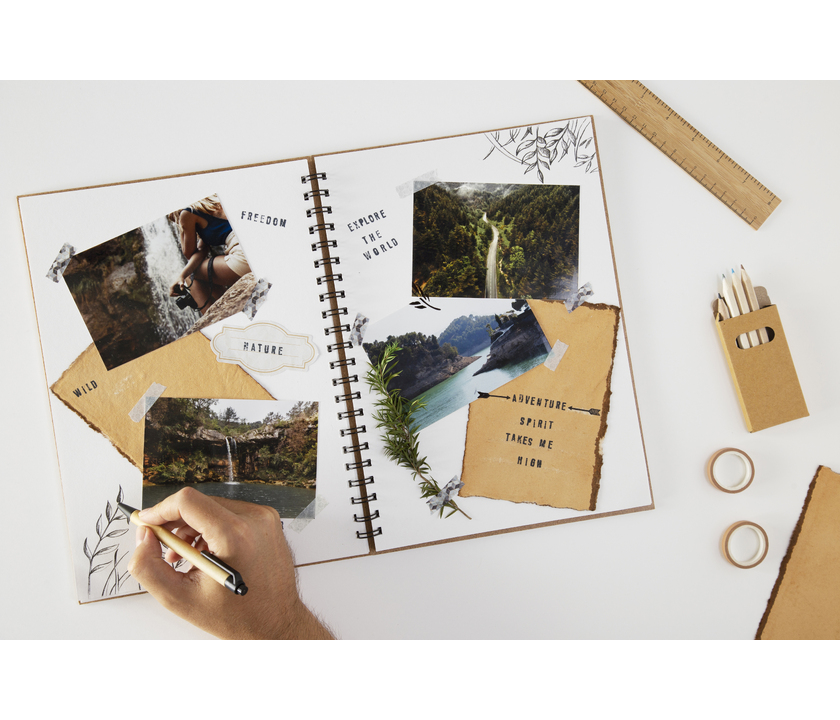The Ultimate Guide to Scrapbook Paper: Types, Sizes, and Uses

Scrapbooking is a creative way to preserve memories, tell stories, and express artistic flair. One of the most essential elements of any scrapbooking project is scrapbook paper. With so many types, sizes, and designs available, choosing the right paper can make a significant difference in your project’s outcome. This guide will explore the various types of scrapbook paper, standard sizes, and how to use them effectively in your scrapbooking projects. By the end, you’ll have the knowledge to select the perfect paper for every creation!
1. Types of Scrapbook Paper
1.1 Patterned Scrapbook Paper
Patterned scrapbook paper features designs, prints, and themes, making it perfect for adding visual interest to your pages. Patterns range from florals and polka dots to seasonal themes and geometric shapes.
- Best Uses: Backgrounds, layering, borders, and embellishments.
- Tip: Use patterned paper sparingly to avoid overwhelming your layout.
Explore our full range of scrapbook paper to find the perfect patterns for your next project.
1.2 Solid-Coloured Scrapbook Paper
Solid-coloured paper is a staple for any scrapbooker. It provides a clean, versatile background that helps other elements stand out.
- Best Uses: Base layers, mats for photos, and journaling spots.
- Tip: Match solid colours with patterned paper for a balanced look.
1.3 Cardstock
Cardstock is a thicker, more durable type of scrapbook paper that holds up well to various techniques, such as stamping, die-cutting, and embossing.
- Best Uses: Card bases, photo mats, and sturdy page elements.
- Tip: Use textured cardstock for added dimension.
1.4 Specialty Scrapbook Paper
Specialty papers include glitter paper, metallic paper, vellum, and acetate sheets. These unique options add texture and sparkle to your layouts.
- Best Uses: Accents, overlays, and special effects.
- Tip: Combine specialty paper with traditional paper for contrast.
Check out our new arrivals for the latest specialty papers.
2. Scrapbook Paper Sizes
Scrapbook paper comes in various sizes to accommodate different project needs. Here are the most common sizes and their uses:
2.1 12x12 Inch Scrapbook Paper
The 12x12 inch size is the most popular choice for scrapbooking. It provides ample space for photos, embellishments, and journaling.
- Best Uses: Traditional scrapbook layouts, background pages, and larger projects.
- Tip: Use a full 12x12 sheet as your base or cut it down for layering.
2.2 8.5x11 Inch and A4 Scrapbook Paper
This size is ideal for smaller layouts and easier to store in binders. A4 paper (8.27x11.69 inches) is slightly taller and narrower than 8.5x11, commonly used in international projects.
Best Uses: Quick pages, journaling sheets, and mixed-media projects.
Tip: Use 8.5x11 or A4 sheets when you want a more streamlined look.
2.3 6x6, 8x8, and 6x8 Inch Scrapbook Paper
Perfect for mini albums, card making, and smaller layouts. These sizes often come in pads with coordinated designs. 8x8 offers a bit more room for detailed designs, while 6x8 is great for pocket-sized albums and travel journals.
Best Uses: Small projects, card fronts, layering, and mini albums.
Tip: Keep a stack of 6x6, 8x8, and 6x8 paper pads handy for quick crafts.
2.4 4x6 and 3x4 Inch Scrapbook Paper
These smaller sizes are great for pocket scrapbooking and journaling cards.
- Best Uses: Photo mats, pocket pages, and embellishment accents.
- Tip: Pre-cut 4x6 and 3x4 papers save time when creating pocket layouts.
3. How to Choose the Right Scrapbook Paper for Your Project
Selecting the right scrapbook paper can enhance your overall design and storytelling. Consider these factors:
3.1 Theme and Mood
Choose paper that complements the theme of your project. For instance, use floral patterns for a spring theme or bold, graphic designs for a modern look.
3.2 Colour Coordination
Pick colours that match or contrast with your photos and embellishments. Use a colour wheel to find complementary hues.
3.3 Texture and Dimension
Incorporate different textures, such as smooth, embossed, or glittery paper, to add depth and interest to your layouts.
3.4 Project Type
- Albums and Layouts: Opt for sturdy 12x12 cardstock.
- Cards and Mini Albums: Choose smaller sizes like 6x6 or 8.5x11 paper.
- Mixed Media: Use specialty paper that can withstand paints, inks, and adhesives.
4. Tips for Using Scrapbook Paper Effectively
- Layering: Combine solid and patterned papers to create depth.
- Matting Photos: Use cardstock to frame your photos and make them pop.
- Die-Cutting: Cut intricate shapes from patterned or specialty paper.
- Journaling Spots: Create designated areas for writing with solid-coloured paper.
- Borders and Edges: Add strips of patterned paper to frame your layout.
For more creative supplies, explore all our products and bring your ideas to life.
5. Storing and Organising Your Scrapbook Paper
Keeping your scrapbook paper organised ensures it stays in good condition and is easy to find. Here are some storage tips:
- Vertical Storage: Use paper racks or vertical organisers to prevent creases.
- Colour-Coding: Sort papers by colour or theme for easy access.
- Plastic Sleeves: Protect specialty papers in clear plastic sleeves.
Discover the Best Scrapbook Paper for Your Crafting Projects Today!
Choosing the right scrapbook paper is essential for creating beautiful, personalised projects. By understanding the different types, sizes, and uses of scrapbook paper, you can elevate your scrapbooking and let your creativity shine. Whether you need patterned paper, solid cardstock, or specialty designs, Papermaze Scrapbooking Supplies has everything you need to bring your ideas to life.





